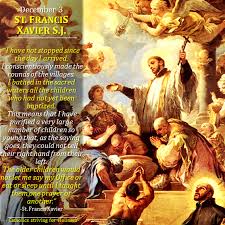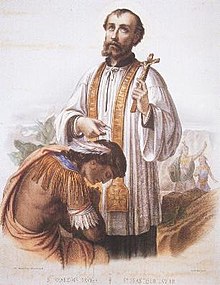Patron of the Missions & Missionaries
Born : April 7, 1506
Died : Dec 3, 1552
Beatified : Oct 21, 1619
Canonised : Mar 22, 1622
 St Francis Xavier, the fifth and youngest child of Juan de Jassu and Maria de Azpilcueta was born in the family castle in Navarre, Spain. He received his early education at home and at nineteen, went to Paris for his university studies. At the College of Sainte-Barbe he shared a room with the young Peter Favre; they were both more interested in their degrees than in their futures until Ignatius of Loyola moved in with them in 1529. Although Peter was won over by Ignatius to become a priest and work for the salvation of souls Francis proved more difficult as he had aspirations of worldly advancement. Francis’ resistance was finally broken when Ignatius put this question to him: “What shall it profit a man if he gain the whole world and lose his soul?’ He yielded to the grace God was offering him through his fellow Spaniard. Together with four others, the seven expressed their commitment to God on August 15, 1534, in the chapel of Saint-Denis in Montmartre, and pronounced their private vows of poverty, chastity and going to the Holy Land to convert infidels.
St Francis Xavier, the fifth and youngest child of Juan de Jassu and Maria de Azpilcueta was born in the family castle in Navarre, Spain. He received his early education at home and at nineteen, went to Paris for his university studies. At the College of Sainte-Barbe he shared a room with the young Peter Favre; they were both more interested in their degrees than in their futures until Ignatius of Loyola moved in with them in 1529. Although Peter was won over by Ignatius to become a priest and work for the salvation of souls Francis proved more difficult as he had aspirations of worldly advancement. Francis’ resistance was finally broken when Ignatius put this question to him: “What shall it profit a man if he gain the whole world and lose his soul?’ He yielded to the grace God was offering him through his fellow Spaniard. Together with four others, the seven expressed their commitment to God on August 15, 1534, in the chapel of Saint-Denis in Montmartre, and pronounced their private vows of poverty, chastity and going to the Holy Land to convert infidels.
Francis began his study of theology in 1534 and was ordained on June 24, 1537. He celebrated his first Mass in Vicenza after forty days in prayers. Francis was one of the two Jesuits, Ignatius sent to the newly settled Portuguese colony in India in response to King John III of Portugal’s request. They set off in Mar 1540 and arrived in Lisbon at the end of June, but the fleet had already sailed for the Far East and the next sailing would be in the following spring. The two Jesuits spent their time preaching in the city and ministering to prisoners. The king was impressed with their work and asked them to remain in Portugal and open a school; thus Providence arranged for Fr Francis to become the first Jesuit missionary there.
 As Fr Francis boarded the Santiago in Lisbon on April 1541 on his 35th birthday, the king’s messenger handed him a papal letter appointing him apostolic nuncio, giving him authority over all Portuguese clergy in Goa, India, He arrived in Goa on May 6, 1542, 13 months after leaving Lisbon, and began his ministry of preaching to the Portuguese, visiting prisons, and ministering to and celebrating Mass for lepers. He tried learning Tamil so that he could reach out to the 20,000 newly converted Paravas who lived in India’s southeastern shore who had been converted between 1535 and 1537, but had been without a priest for years. It was the task of Fr Francis to reinstruct them in the faith they had embraced. He made use of interpreters and for two years went from village to village baptizing all he thought were ready and leaving a catechist in charge when he had to move on. He baptized another 10,000 in the western shore of Travancore in 2 months before moving northward to Cochin when he heard from a traveler that the Molucca Islands were ripe for harvest.
As Fr Francis boarded the Santiago in Lisbon on April 1541 on his 35th birthday, the king’s messenger handed him a papal letter appointing him apostolic nuncio, giving him authority over all Portuguese clergy in Goa, India, He arrived in Goa on May 6, 1542, 13 months after leaving Lisbon, and began his ministry of preaching to the Portuguese, visiting prisons, and ministering to and celebrating Mass for lepers. He tried learning Tamil so that he could reach out to the 20,000 newly converted Paravas who lived in India’s southeastern shore who had been converted between 1535 and 1537, but had been without a priest for years. It was the task of Fr Francis to reinstruct them in the faith they had embraced. He made use of interpreters and for two years went from village to village baptizing all he thought were ready and leaving a catechist in charge when he had to move on. He baptized another 10,000 in the western shore of Travancore in 2 months before moving northward to Cochin when he heard from a traveler that the Molucca Islands were ripe for harvest.
From Cochin he left for Sao Thome (now part of Madras) where he visited the tomb of St Thomas the Apostle. In Sep 1545 he embarked for the Portuguese city of Malacca in Malaya which was a stopping point for him before he sailed off to the Moluccas, the famed Spice Islands. For 3 months he visited the Moluccas Christian villages and baptized 1000 persons in Seran. He returned to Malacca where he met Anjiro, a Japanese nobleman interested in becoming a Catholic and through him Fr Francis learned about Japan. It was not until April 1549, that he, Anjiro and several other Jesuits set sail for Japan, a land that had not yet heard about Christianity. Fr Francis hired a pagan pirate’s junk and arrived in Kagoshima in southern Japan after 2 months. There Anjiro secured an audience with the local prince who readily gave the Jesuits permission to preach Christianity. However Fr Francis was not able to get to the Emperor in order to convert him and the nation. So after a year in Kagoshima and after 100 converts. They left for Hirado a port used by Portuguese on the upper coast of Kyushu. Within 2 months he made 100 converts but further success eluded him until they decided that they should try and get an audience with the most powerful lord in Japan, dressed as richly-clad nobles and not as poorly-clad Europeans as before. So dressed in colourful, flowing silken robes with turbans on their heads and riding on fine horses they were able to gain access to the daimyo’s (lord) palace and presented him with priceless gifts. After the daimyo had accepted these signs of friendship, the missionary presented his credentials, letters from King John III of Portugal and Pope Paul III and was given permission to preach the Christian religion in the empire. At the same time the daimyo also gave permission for Japanese to embrace the Christian faith and also allowed the missionaries to build a monastery as their residence in the city.
![]() After appointing another Jesuit to take over, Fr Francis decided to return to Malacca and India with the hope of returning to Japan the following year. However 7 days out from Japan, the ship was caught in a typhoon and was drawn into a whirlpool and it was finally cast out some thousand of miles off course. On Dec 1551, the vessel entered the Bay of Canton and dropped anchor off Sancian Island. When his eyes looked toward the distant land of China, Fr Francis felt China’s call. When he arrived in Singapore, he found Fr Ignatius’ letter informing him he had been appointed provincial of the “Indies and the countries beyond”. He reached India and was informed that he was to go to Rome to report on the status of his mission. But Fr Francis felt the report could wait until he had visited China.
After appointing another Jesuit to take over, Fr Francis decided to return to Malacca and India with the hope of returning to Japan the following year. However 7 days out from Japan, the ship was caught in a typhoon and was drawn into a whirlpool and it was finally cast out some thousand of miles off course. On Dec 1551, the vessel entered the Bay of Canton and dropped anchor off Sancian Island. When his eyes looked toward the distant land of China, Fr Francis felt China’s call. When he arrived in Singapore, he found Fr Ignatius’ letter informing him he had been appointed provincial of the “Indies and the countries beyond”. He reached India and was informed that he was to go to Rome to report on the status of his mission. But Fr Francis felt the report could wait until he had visited China.
He left India in Apr 1552 and landed on desolate Sancian Island in Sep. While waiting for smugglers to take him to China, Fr Francis was taken ill with a fever and was confined to his leafy hut. His Christian Chinese servant, Antonio faithfully cared for him during his final illness, and years later, wrote an account of the Saint’s last days. On Nov 26 Fr Francis went into a coma but regained consciousness on Dec 1 during which time he prayed constantly until the morning of Dec 3, when he went to heaven. His body was buried on the island, and was taken to Malacca subsequently. It was removed to Goa a few years later where his remains were interred in the church Bom Jesus.
Fr Francis was canonized by Pope Gregory XV on March 12, 1622.
